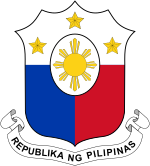
Back شعار الفلبين ARZ Eskudo kan Filipinas BCL Герб Філіпінаў Byelorussian ফিলিপাইনর চিনত্হান BPY Grb Filipina BS Escut de les Filipines Catalan Státní znak Filipín Czech Wappen der Philippinen German Εθνόσημο των Φιλιππίνων Greek Blazono de la Filipinoj Esperanto
| Coat of arms of the Philippines | |
|---|---|
 | |
| Versions | |
 Version with the colonial charges removed, as passed by Congress in 1998. It remains unofficial as no referendum has been called. | |
| Armiger | Republic of the Philippines |
| Adopted | July 3, 1946 |
| Shield | Paleways of two (2) pieces, azure and gules; a chief argent studded with three (3) mullets equidistant from each other; and, in point of honor, ovoid argent over all the sun rayonnant with eight minor and lesser rays |
| Compartment | Beneath shall be the scroll with the Name of the Country in Filipino inscribed thereon |
| Motto | Republika ng Pilipinas |
| Other elements | Bald eagle of the United States and lion rampant of Spain (the charge of the Kingdom of León) |
| Part of a series on the |
| Culture of the Philippines |
|---|
 |
| Society |
| Arts and literature |
| Other |
| Symbols |
|
Philippines portal |
The coat of arms of the Philippines (Filipino: Sagisag ng Pilipinas; Spanish: Escudo de Filipinas) features the eight-rayed sun of the Philippines with each ray representing the eight provinces (Batangas, Bulacan, Cavite, Manila, Laguna, Nueva Ecija, Pampanga, and Tarlac) which were placed under martial law by Governor-General Ramón Blanco Sr. during the Philippine Revolution, and the three five-pointed stars representing the three major island groups of Luzon, the Visayas, and Mindanao.[1]
On the blue field on the dexter side is the North American bald eagle of the United States, and on the red field on the sinister side is the lion rampant of the coat of arms of the Kingdom of León of Spain, both representing the country's colonial past. The current arms, which shares many features of the national flag, was designed by Filipino artist and heraldist Captain Galo B. Ocampo.
- ^ "Independence Day facts you're probably not aware of". cnn. Archived from the original on December 27, 2021. Retrieved December 27, 2021.
© MMXXIII Rich X Search. We shall prevail. All rights reserved. Rich X Search